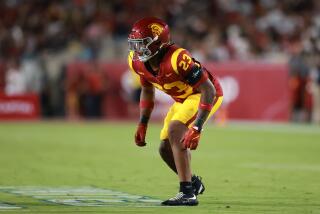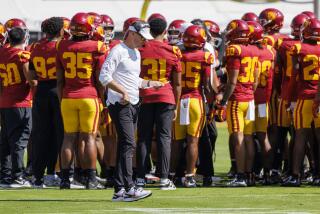USC Linebacker Ron Brown Loses the Weigh-In, Wins the Fight
- Share via
Some people enjoy eating little snacks during the day to satisfy hunger pangs.
Ron Brown, USC’s weak-side outside linebacker, eats for a different reason--and he doesn’t enjoy it.
A lightweight linebacker last year at 200 pounds, Brown was determined to gain weight, so he began stuffing himself with bananas. Soon, Brown was eating a dozen a day.
“You think of it as a workout, even though you hate working out,” said Brown, who got a side benefit in that the potassium in the bananas has alleviated leg cramps he used to suffer while playing.
But why bananas? Why not steak or pasta?
Brown, a senior, just smiled and said: “I’m just a poor college student. I couldn’t afford much else.”
So Brown chose bananas and now weighs 217 pounds. He’s still at a weight disadvantage, though, when taking on 280- or 290-pound offensive linemen.
Brown said he lines up at least half the time in a down stance as a defensive lineman. He doesn’t believe, though, that a bulky offensive tackle should get the best of him.
“When it comes down to man to man, it’s just determination . . . a mental attitude,” Brown said. “I’m just not going to let this guy kick my butt. I’m a man and he’s a man, so who is better?
“I could weigh 450 pounds, but it wouldn’t matter if I didn’t have the attitude he’s not going to drive me off the line.”
A first-time starter this season, Brown distinguished himself in USC’s 29-20 loss to Arizona State Saturday at the Coliseum.
He prevented a possible touchdown in the third quarter by smashing tailback Darryl Harris for a two-yard loss on third and goal from the USC two-yard line. The Sun Devils settled for a field goal.
Later, after a USC turnover, Arizona State lined up on second and six at the Trojan 22. Brown broke through and nailed fullback Channing Williams for a three-yard loss. The Sun Devils eventually scored, but Brown had done his part.
Donnie Rea, who coaches USC’s outside linebackers, said Brown has performed creditably against larger linemen, such as 300-pound Don Robinson of Baylor and 293-pound Danny Villa of Arizona State.
“Even though we lost, Villa didn’t knock Brown off the ball at any one time,” Rea said.
Brown forsook what might have been a promising track career to play football. While at Bishop Amat High School in 1982, he had the seventh-fastest prep high hurdles time in the country, 13.82 seconds.
He recalled that he regularly beat Danny Harris of Perris High in the 300-meter low hurdles. Harris went on to earn a silver medal in the 400-meter intermediate hurdles at the 1984 Olympic Games.
Brown’s hurdling career took a detour in 1983 when he tore ligaments in his left knee, requiring surgery. A football-related injury to his right knee forced him to red-shirt in 1984.
“Renaldo Nehemiah was teaching me some new hurdling techniques, and I came down from a hurdle with my knee hyper-extended and it shot off to the side,” Brown said. “I really miss track. That’s where my heart lies.”
Brown still works out with the track team but hasn’t competed for USC since 1984.
“It was just too much of a weight fluctuation for the position I play,” he said. “In track, my normal weight would be 190 pounds.”
Brown was a two-way lineman in high school, but he yearned to become a running back. The backfield positions were filled, however, and there was a shortage of linemen, so that’s where he stayed.
Brown backed up Marcus Cotton on the weak side last year, and when Cotton was moved to the strong side this season, Brown moved in as the starter.
Asked to define the responsibilities of weak-side and strong-side outside linebackers, Brown said: “The strong-side backer plays over a tight end all the time and he’s supposed to squeeze the ball to the inside as much as possible, so the inside linebackers can make the tackle.
“As a weak-side backer, if the ball comes to my side, I have to make sure that I stretch the play to the sideline. The positions are totally opposite in responsibilities.”
USC will confront a formidable quarterback Saturday at Palo Alto in Stanford’s John Paye, an able scrambler and an accurate passer. But Brown doubts that Paye is more agile than USC’s Rodney Peete.
“It helps you to practice against a quarterback like Rodney, but it also hurts you,” Brown said. “A lot of times you’re being extra safe on the outside, feeling this guy is going to run like Rodney does. But I haven’t played against anyone as fast as Peete. He looks fast, but when you go against him, he’s five times faster than you thought.”
It is taken for granted that athletes don’t like to lose, but defeats gnaw at some people more than others. Brown is one.
“I just want Saturday to get here so I can get that feeling of winning again,” Brown said, gritting his teeth. “I just hate having to walk around with that (losing) feeling in my gut. I feel I’m going to win. I’m not going to lose.
“When it comes to losing, Rex Moore (inside linebacker) and I have the same personality. We hate it.”
Trojan Notes How times have changed Dept.: USC is the Pacific 10’s third-leading passing team, and Stanford is fourth. However, the Trojans, who used to be among the leaders in rushing offense, are sixth in the league, averaging only 141.8 yards a game. Moreover, USC is eighth in the conference in total defense, yielding 387.3 yards a game, and Stanford is fifth at 334.5. The Trojans are ninth in rushing defense, 191.7, and Stanford is third, 99.2. . . . USC was burned by Oregon and Arizona State on delayed passes to a tight end or a running back. There are holes in a zone defense when the Trojans elect to rush four men, and teams have been taking advantage of it. . . . Barry McKeever, a starting inside linebacker for Stanford, is the son of the late Mike McKeever and nephew of Marlin McKeever, former USC All-Americans. Barry’s sister, Teri, is a former All-American swimmer at USC and is now an assistant swimming coach at the school. Coach Ted Tollner said USC tried to recruit McKeever, but he reportedly didn’t want to follow in his father’s or uncle’s footsteps. “It was a positive, healthy recruiting situation, but we lost,” Tollner said.
More to Read
Go beyond the scoreboard
Get the latest on L.A.'s teams in the daily Sports Report newsletter.
You may occasionally receive promotional content from the Los Angeles Times.






